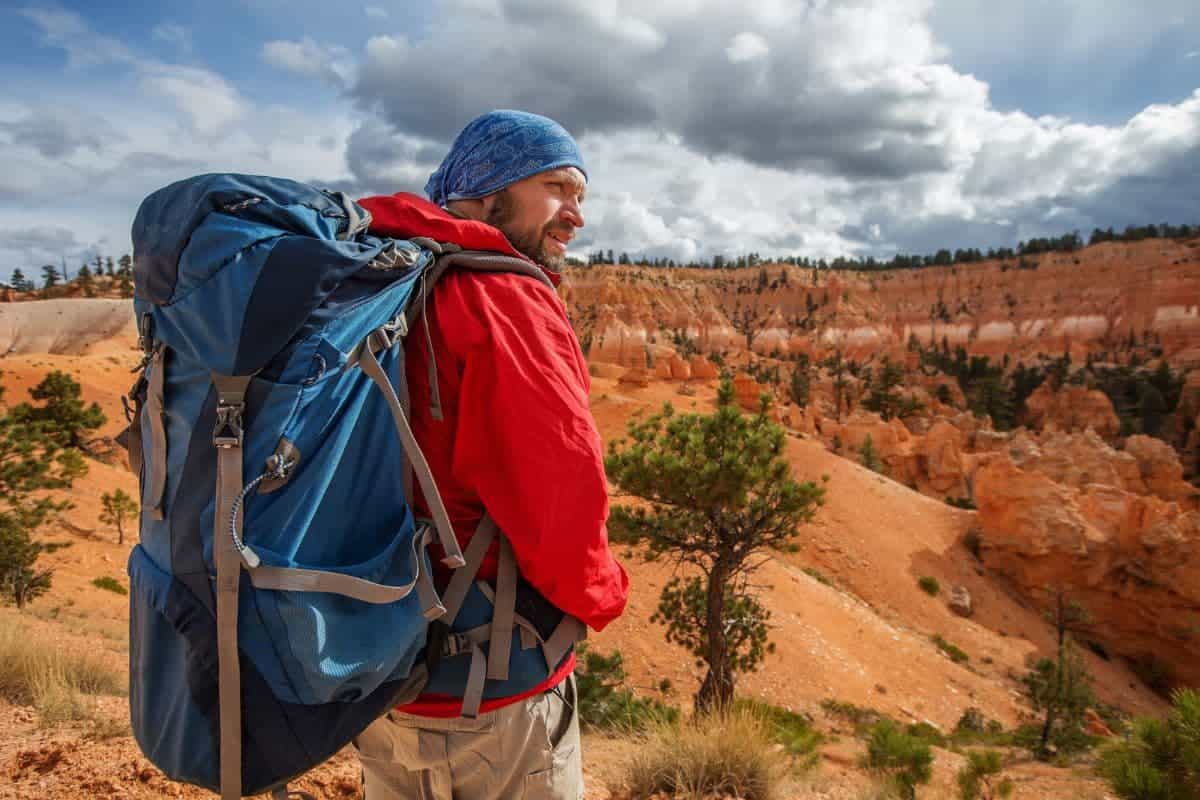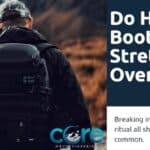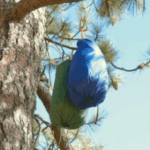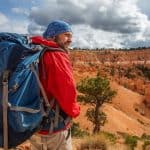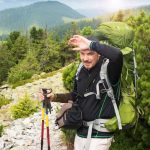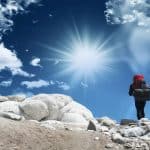Backpacking across the U.S. is like flipping through a book of breathtaking landscapes. We really do have the most butifull backpacking trails here. With a wide range of landsacaps for everyone.
What you crave in an adventure—be it the thrill of scaling rugged peaks or the peace of meandering through woods—will steer you towards the right trail.
Before planning on your next journey, make sure you’ve done your homewor. Understanding the trail’s demands, securing necessary permits, and picking the optimal season can make or break your long-distance hike.
Let me help you along your way, by finding the best states for your next hiking trip!
Article Highlights
- The best state for backpacking aligns with your adventure preferences and experience levels.
- Planning is essential, taking into account trail difficulty, permits, and ideal seasons for travel.
- Post-trip reflections can enhance future backpacking experiences and inform others.
Best Backpacking States
Here are some of the top backpacking states across the United States, showcasing the unique natural wonders and diverse landscapes that each offers to outdoor enthusiasts.
| State | Features | Highlights |
|---|---|---|
| Washington | Temperate rain forests and snow-capped peaks | Olympic National Park, North Cascades, Mount Rainier, and the Enchantments in Central Washington |
| Utah | Striking red rock formations and canyons | Surreal landscapes with arches, canyons, reds at every turn, gateway to desert adventure |
| Alaska | Wilderness with expansive untamed landscapes | Kenai Fjords National Park, glaciers meeting ocean, vast outdoor adventure |
| Colorado | The Rockies and alpine lakes | Diverse backpacking trails through the Rockies and other natural landscapes |
| West Virginia | Appalachian Mountains’ rolling beauty | Forested paths and mountain culture in the Appalachian terrain |
| California | Diverse ecosystems from beaches to forests | Varied environments from misty redwood forests to beaches and Sierra Nevada mountains |
| Arizona | Iconic desert trails and the Grand Canyon | Vast desert landscapes, cactus-studded scenery, and geologic exploration |
| Wyoming | Yellowstone and rugged natural wonders | Yellowstone’s geothermal wonders, sprawling ranges, and abundant wildlife |
| Maine | Picturesque coastal trails and thick pine forests | Coastal paths with ocean views, lighthouses, and pine forests |
A list of is all well and great, but let’s get into why I choose these states and see if they aline with what you’re looking for.
Choosing the Right State
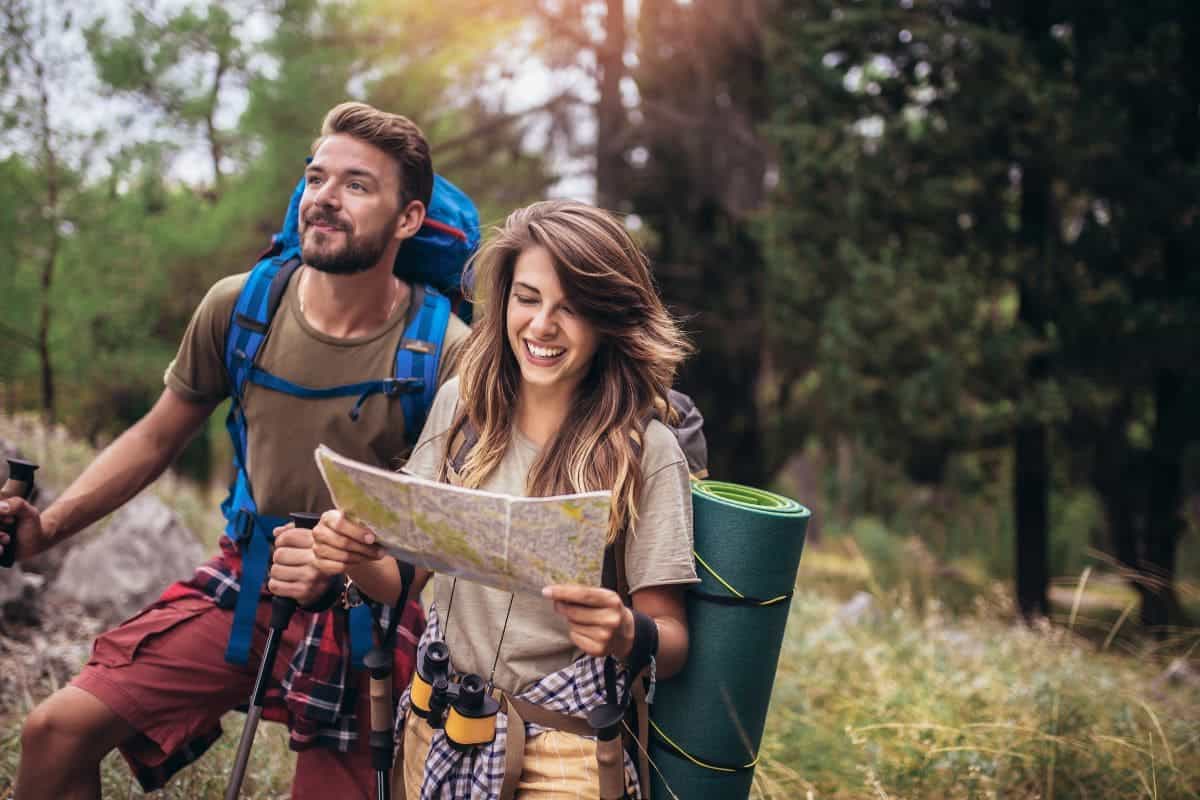
Selecting the ideal state for your backpacking adventure hinges on what you’re looking for in terms of landscapes and experiences. Here’s a breakdown to guide you through the myriad of options.
Factors to Consider
When you’re deciding where to strap on your hiking boots and hit the trails, it’s crucial to mull over a few key details:
- Scenery: Are you drawn to mountains, deserts, or coastal views?
- Wildlife: Keep in mind the types of flora and fauna you want to encounter.
- National Parks: They often offer well-maintained trails and unforgettable sights.
- Wilderness: The level of remoteness can vary greatly from state to state.
Essentials of Backpacking
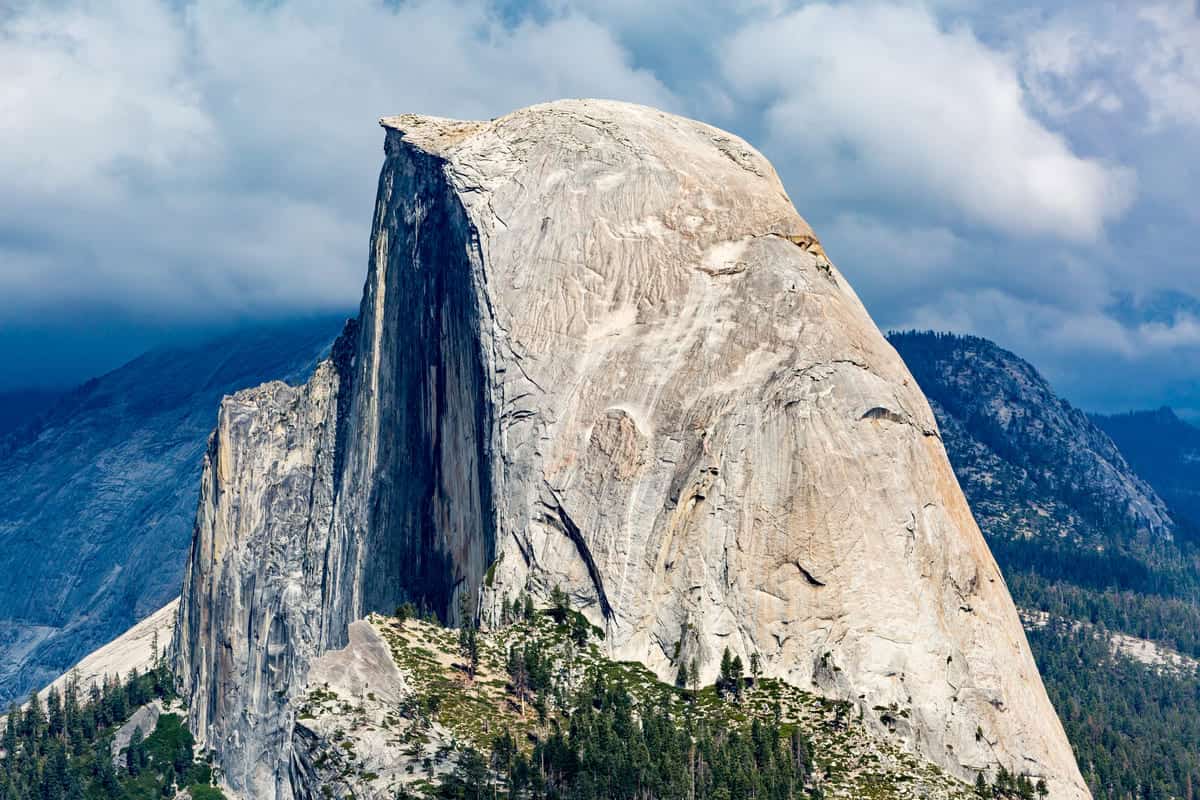
Backpacking Basics
Your backpacking trip starts with choosing the right trail. If it’s a day hike you’re after, look for a trail that matches your fitness level and time constraints. For longer excursions, consider factors like water sources, campsites, and elevation changes.
Always leave an itinerary with a friend or family member before you depart.
Gear and Equipment
When selecting your gear:
- Shelter: A lightweight tent or hammock will protect you from the elements.
- Backpack: An appropriately sized pack will help balance the load on your trek.
- Sleeping Bag: Account for the climate; a summer bag won’t suffice in the cold.
- Cooking Supplies: A compact stove and cookware are essentials for hot meals.
- Clothing: Wear layers and pack extra socks. Moisture-wicking materials are best.
Safety Precautions
Stay on marked trails to avoid harming the environment or getting lost. Carry a first aid kit tailored to your and your group’s needs.
Know how to respond to encounters with wildlife by familiarizing yourself with the animals in the area you’ll be visiting.
Backpacking Etiquette
Leave no trace on your hikes. This includes:
- Pack out all trash.
- Minimize campfire impacts.
- Respect wildlife and fellow hikers by keeping noise to a minimum and giving animals space.
Navigation and Route Planning
It’s easy to get lost, especially if signs are missing or you wander off the trail.
Core Mountaineering Pro-Tip: Always carry a trail map and compass or a GPS device to navigate your route. Even on well-marked paths, being proficient in reading your surroundings is crucial for safe and enjoyable backpacking.
Popular Trails and Routes
1. Alpine Adventures
Alpine Lakes Wilderness in Washington is a form of rugged beauty, home to the much-revered Sahale Glacier hike. Here, you’ll find routes like the Enchantments, with its sparkling alpine lakes and dramatic granite peaks.
Expect substantial elevation gain and the chance to spot mountain goats along your journey.
- Hidden Lake Lookout
- Gothic Basin
2. Beach and Coastal Trails
Want to hear the ocean’s call as you trek? Olympic National Park offers legendary beach hikes.
- Rialto Beach to Hole-in-the-Wall
- Second Beach and Shi Shi Beach
Both trails give you a mix of sandy shores and rocky intertidal zones, often with the backdrop of dramatic sunsets.
3. Forest and Valley Hikes
If you’re captivated by the idea of ancient trees and lush green canopies, the trails through old-growth forests will feel like a fairy tale.
Each track offers a journey through living history, with towering trees and rich biodiversity.
- Enchanted Valley via the Quinault River
- Hoh River Trail
4. High Elevation Hiking
For those of you who seek the thrills of high-altitude treks:
- Sahale Glacier Camp
Prepare for significant elevation gains, thinner air but also extraordinary panoramic views, and the feeling of being atop the world.
Difficulty and Trail Ratings
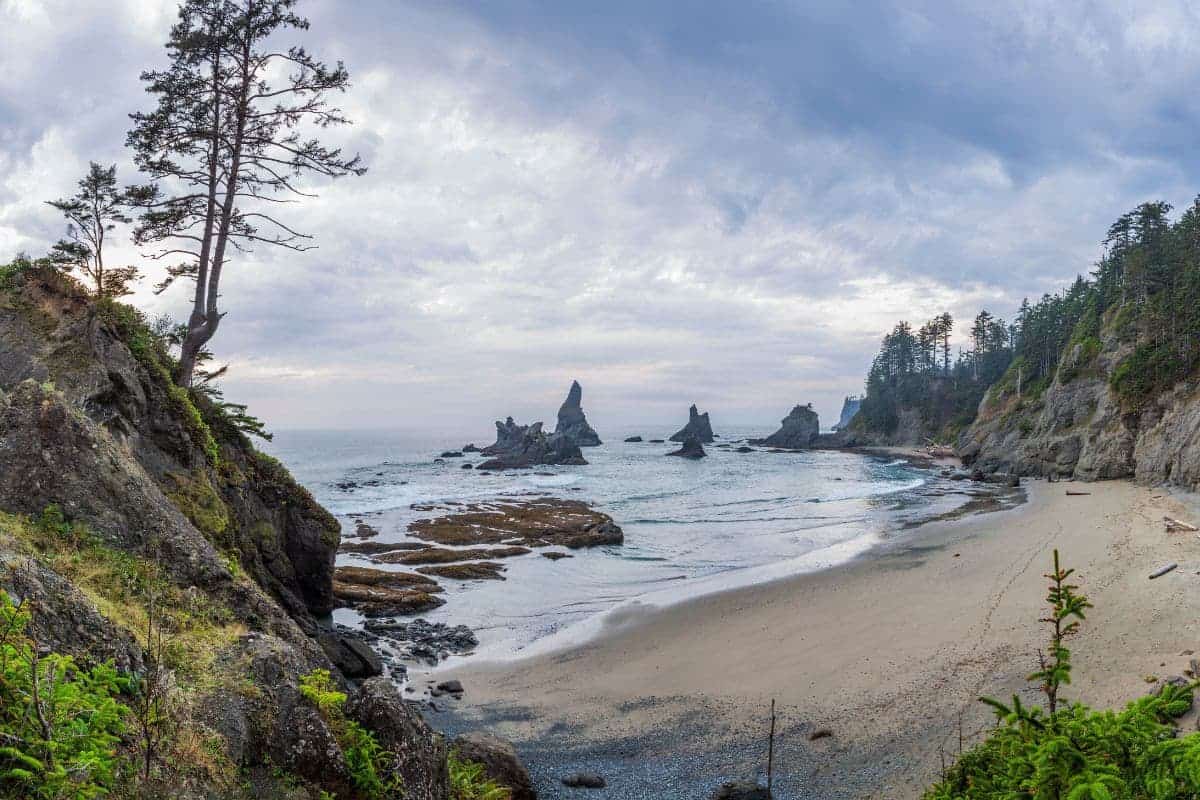
When you’re eager to set out on a backpacking adventure, understanding trail ratings is necessary for your safety and enjoyment. Based on difficulty, terrain, and elevation changes, these ratings assist in choosing a trail fit for your skill level, be it a leisurely walk or a rigorous trek.
1. Assessing Trail Challenges
Pay close attention to the descriptions of switchbacks, boulders, and mud. Frequent switchbacks might indicate steep ascents, while boulders suggest technical hiking that may require climbing or scrambling. Mud affects the trail’s trek-ability, necessitating proper footwear.
Trails are usually rated based on their clarity of marking and the terrain involved. Some paths are well-signed, making navigation a breeze.
If you stray into an area where trails become faint, you’ll need a good map and the ability to read the landscape.
2. Beginner-Friendly Trails
If you’re new to backpacking, look for trails with minimal elevation gain and easy terrain. A hike with less than 1,000 feet of elevation change and a distance under 5 miles is ideal for beginners.
Consider starting with a well-maintained trail like the Wonderland Trail, where you’ll find clear paths, marked campgrounds, and gradual inclines. This will help build your confidence before you tackle more challenging routes.
3. Trips for Experienced Backpackers
Once you have a few trails under your belt, you can aim for hikes with over 2,000 feet in elevation gain and steeper grades.
Trails like the High Divide loop offer stunning views and the thrill of more demanding terrain.
If you’re up for a really serious challenge, a thru-hike might be your calling. This involves covering long distances, such as an entire trail system, which requires physical stamina, proper gear, and thorough preparation.
As you journey these trails, always respect your limits and remember to check for the most recent condition reports. Your backyard wilderness awaits, but it’s up to you how deep into the wild you venture.
Natural Attractions and Landmarks
Lakes and Waterfalls
Imagine dipping your toes into the cool waters of Gem Lake after a long trek or casting your gaze upon the majestic Sol Duc Falls cascading through the lush greenery of Washington’s Olympic National Park.
If you trek through the Seven Lakes Basin, you’ll be treated to not just one, but a series of alpine lakes, each offering its own unique view and crystal-clear waters.
Mountain Peaks and Glaciers
Heading north to Alaska, you can marvel at the mighty Johannesburg Mountain, or if you’re up for a real challenge, set your sights on Sahale Glacier Camp for stunning panoramic views.
In Washington, Mount Baker and Glacier Peak stand tall amid the Cascade Range, dotted with blue glaciers that carve through the landscape, creating some of the most picturesque scenes you’ll ever hike through.
Remember, every state’s unique topography delivers its own version of these natural wonders, so wherever you go, you’ll find something that takes your breath away.
Flora and Fauna
As you wind along trails, keep an eye out for vibrant wildflowers dotting the landscapes from California’s Sierra to the rugged peaks of Utah.
Meanwhile, the temperate rain forest of the Pacific Northwest offers a lush, green escape where every step takes you deeper into a world teeming with life, from the towering canopy above to the rich undergrowth below.
Seasonal Concerns
Best Times to Visit
The high season for most trails is summer, but if you’re eyeing the Pacific Northwest, late summer to early fall is prime. That’s when the wildflower meadows are in full bloom, and the skies are clearest. For trails around glaciers, summer is also the best bet, as you’ll get access without as much of the chill.
- Wildflower Meadows: Late summer through early fall.
- Pacific Northwest: July to early October.
- Glaciers: July through September.
Weather Patterns
Expect the unexpected—weather can be fickle. In mountain regions, afternoon thunderstorms are common in summer. The Pacific Northwest, on the other hand, tends to have a wet climate, so waterproof gear is a must.
However, the upside is its temperate weather, which makes backpacking pleasant, even in the shoulder seasons.
| Region | Typical Summer Weather | Typical Shoulder Season Weather |
|---|---|---|
| Pacific Northwest | Cool with potential for drizzle | Mild but with more frequent rain |
| Mountains | Warm days, chilly nights | Cool days, cold nights |
| Glaciers | Moderate with clear skies | Unpredictable, cooler with snow likely |
Dealing with Snow and Ice
When snow and ice are part of the landscape, you’ll need the right gear—think crampons and ice axes for glaciers, and maybe snowshoes for early season or high-altitude hikes.
Core Mountaineering Pro-Tip: Be aware that daylight hours diminish in winter, reducing the time available for trekking each day. Plan accordingly to maximize your outdoor experiences within the available daylight.
- Glacial Trails: Bring crampons and be prepared for icy conditions.
- Snowy Trails: Consider snowshoes and always check avalanche risks before heading out.
Camping and Overnight Trips
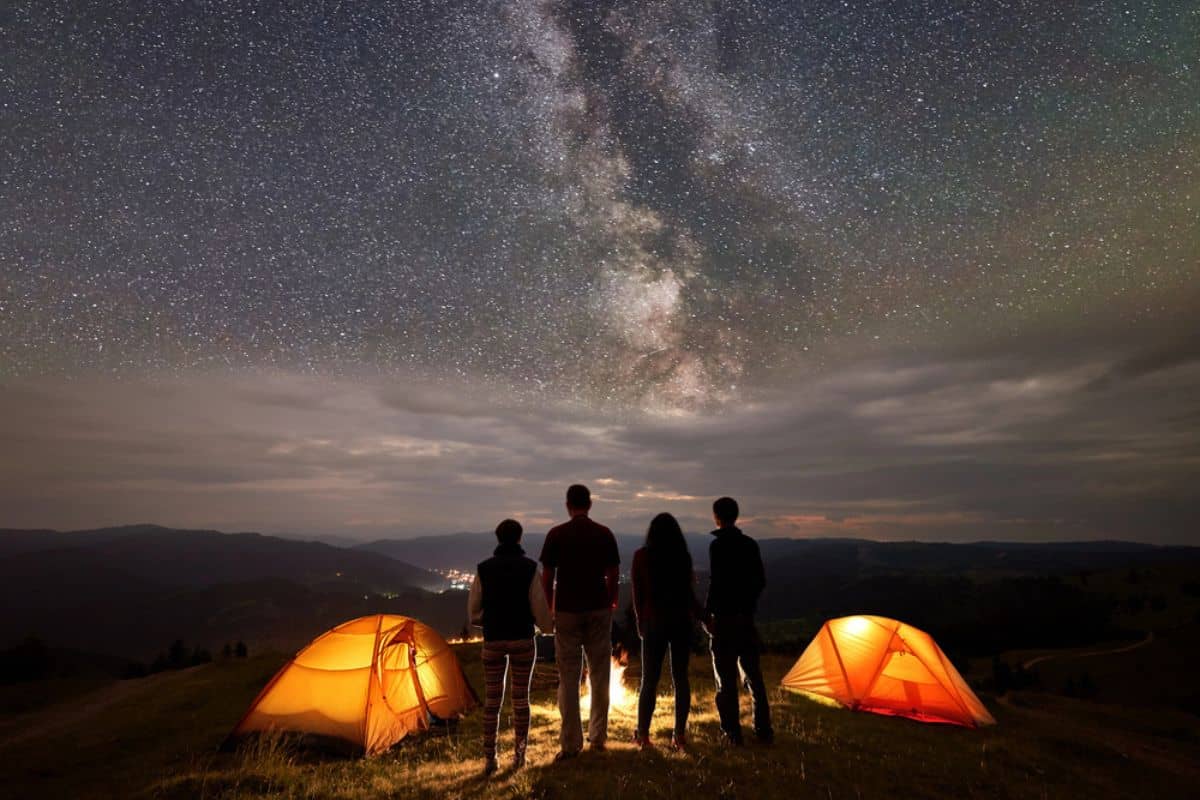
When you’re planning your backpacking trip, the camping and overnight aspects are some of the most exciting parts. You’ll get to unwind beneath the stars after a day of trekking and have a chance to connect with the wilderness.
Here’s how you ensure your camping experience is as top-notch as your hiking adventure.
1. Selecting Campsites
Before setting up your tent, scout for a spot that’s, ideally, 200 feet away from trails, water sources, and ledges. Look for a site with natural shelter from wind and a flat area to avoid an uncomfortable night’s sleep. Campsites that are well-established and less sensitive to wear are your best bet to minimize your impact.
2. Backcountry Regulations
Each park and wilderness area has its own rules you need to follow.
For instance, overnight hikes on the Teton Crest Trail or in Glacier National Park require permits.
Be sure to check if campfires are allowed or if you must pack a portable stove. Stick to group size limits for your safety and to preserve the serenity of the backcountry.
3. Leave No Trace Principles
Being a responsible camper means adopting Leave No Trace Principles:
- Be ready for extreme weather, hazards, and emergencies.
- Stick to trails and established campsites.
- Pack it in, pack it out.
- Preserve the past; don’t touch cultural or historic structures and artifacts.
- Use a lightweight stove or use established fire rings.
- Watch from a distance and store your food securely.
- Maintain a quiet presence and respect others on the trail.
4. Photography and Journaling
Capture your trip with photos but remember to keep the flash off to avoid disturbing wildlife. Try journaling to remember the details of your days and nights.
Your journal and photos will let you relive the trip for years to come. Remember to keep your camera handy, but stored in a waterproof bag to protect against the elements.
State-Specific Regulations
Park Permits and Fees
Olympic National Park in Washington, for example, requires permits for backpacking, especially from May 15th to October 15th for higher elevations. These permits can be reserved starting April 15th. Always check the park’s official website or call their office for the most current permit requirements and fees.
- Permit Reservations: Available six months from the desired date
- Contact: Park office for further details
Fire Restrictions and Regulations
Fire regulations are important for your safety and environmental protection. Rules can vary greatly depending on drought conditions and wildfire risks. Remember to check with the local park or forest service about campfire policies and any seasonal fire restrictions.
- Washington: Verify with Washington Trails Association for current regulations
- Colorado: Check regulations for each park, as they might differ
Wildlife Protection Laws
Your interaction with wildlife must comply with local laws to keep both you and the animals safe. In many states, it’s illegal to feed wildlife; doing so can lead to fines. Proper food storage, often requiring bear-proof containers, is essential to prevent attracting animals to your campsite.
- Protect Wildlife: Never feed or approach wildlife
- Food Storage: Use bear-proof containers where required
Your compliance with these state-specific regulations ensures the trails remain beautiful and accessible for years to come, and that you have a memorable backpacking trip.
Trail Maintenance Efforts
Trail maintenance is a key component of your backpacking experience, and many states have volunteer programs for trail upkeep. It’s your responsibility to leave trails better than you found them, so follow Leave No Trace principles and participate if possible.
- Volunteer: Join trail maintenance efforts
- Leave No Trace: Minimize impact by staying on trails and packing out trash
Preparing for the Adventure
1. Physical Training
Regular cardio activities like running, cycling, or swimming will build your endurance for the long treks ahead. Start slow and gradually increase your pace and distance.
Focus on leg strength with exercises such as squats and lunges. Core exercises will also help with your balance when crossing challenging trails or rock formations.
2. Mental Readiness
Read about the experiences of others who have backpacked in the state you’re interested in to understand potential mental challenges. Additionally, imagine yourself successfully traversing mountain vistas and overcoming obstacles to prepare mentally for the journey.
Group vs Solo Backpacking
| Backpacking Type | Pros | Cons |
|---|---|---|
| Group | Shared resources, companionship, combined wilderness knowledge | Must align on goals and pace |
| Solo | Complete autonomy, personal growth opportunities | More self-reliance required, safety concerns |
3. Understanding the Terrain
Study maps and trail guides to familiarize yourself with the area. Note the locations of water sources and emergency exits.
Moreover, be aware of the typical weather conditions for the time of year you’re going. Always prepare for sudden weather changes, which can dramatically affect terrain conditions.
After the Trip
Post-Hike Recovery
After days of trekking and sleeping under the stars, your body needs to recuperate. Take it easy for a couple of days to let your muscles rest. Hydrate well and consider a light stretch or yoga to ease any stiffness.
Sharing Your Experience
Do you have some epic shots of the Rocky Mountain National Park or that stunning sunrise in Maine? Now’s the time to sort through those photos and pick your favorites. Share them with friends or on social media but remember to keep the locations of sensitive and pristine areas vague to protect them.
Planning Your Next Adventure
Can’t shake off the backpacking bug? Start plotting your next trip!
- Reflect: What did you love about this trip?
- Research: Is it the enchanting valleys of Washington State you want to take next?
- Budget: Start saving for your next set of experiences.
Conservation and Advocacy
Your backpacking trips make you a firsthand witness to the beauty of nature—and its fragility. Consider joining conservation efforts or supporting policies that protect our wild places.
- Volunteer: Trail maintenance, anyone?
- Advocate: Speak up for public lands and responsible usage.
Community Engagement
Core Mountaineering Pro-Tip: Talk with fellow backpackers to exchange stories, share gear advice, and coordinate group outings. Building a network can enhance your experience and provide valuable insights and companionship on the trail.
You’ll find communities online or local clubs eager to welcome new members. Social media groups and platforms like Meetup are great places to start.
Tips and Tricks
Packing Efficiently
Your backpack is your lifeline, so pack it wisely.
- Start with the essentials: a tent, sleeping bag, and a cook system. Use a compression sack for your sleeping bag to save space.
- Clothes should be versatile and layerable—think synthetic layers that are lightweight and moisture-wicking.
- Remember the rule of threes: one to wear, one to wash, and one as a spare. Roll your clothes to minimize wrinkles and maximize space.
- Pack items in the order of use; the less you need it, the deeper in the pack it goes.
Trail Snacks and Nutrition
Start your day with a hearty breakfast like oatmeal mixed with protein powder, and end with a satisfying dinner such as dehydrated meals that are easy to prepare.
Don’t underestimate the importance of food for morale and energy. Plan your meals to include a balance of carbohydrates, proteins, and fats:
- Energy bars, granola, dried fruits
- Nuts, seeds, jerky
- Nut butters, trail mix
Hydration Strategies
Ensure you start your hike well-hydrated, and then maintain hydration by drinking small amounts frequently. Moreover, carry a water filter or purifier to refill from natural sources.
Additionally, consider using a hydration pack for easy sipping on the go, and don’t forget to add electrolyte tablets or powders to your water to replenish salts lost through heavy perspiration.
Tackling Challenging Segments
Know when you’re approaching a difficult part of the trail and prepare mentally and physically. Take it slow, maintain a steady pace, and use trekking poles for balance and support. Furthermore, practice deep breathing to steady your heart rate and don’t shy away from taking short breaks to prevent burnout.
Avoiding Common Mistakes
Among the common pitfalls of backpacking are over packing and neglecting foot care. Therefore, make sure to test your gear before the trip.
To avoid blisters, break in your boots well in advance, and carry duct tape for managing hot spots or making gear repairs.
Additionally, always inform someone of your itinerary and expected return, even if you plan only a short trip.
Maximizing Enjoyment
Lastly, keep in mind that backpacking is about the experience. Capture memories with photos, but ensure you also enjoy the moment without being overly fixated on your camera lens. Maintain a positive attitude, interact with fellow hikers, and remain open to the unexpected. Since each trip is unique, fully grab your adventure.
Further Resources
Recommended Reading
- “The Top 10 Best U.S. States For Hiking (2024)” – For insights on prime hiking destinations in the U.S., this is your go-to guide.
- “Backpacker Magazine” – A staple for trail reviews, gear recommendations, and tips.
Websites and Apps for Hikers
- AllTrails: This comprehensive resource offers trail maps and user reviews.
- Recreation.gov: Essential for obtaining your permits and learning about different trails.
Guided Tours and Packages
- REI Adventures: They offer expert-led trips that cater to various skill levels.
- Local outfitters: Check for state-specific offerings, such as guided hikes in Colorado’s Rocky Mountain National Park.
Backpacking Communities and Forums
- Reddit’s r/backpacking: Join the conversation with fellow backpacking enthusiasts.
- Backpacking groups on Facebook: A space to exchange stories and advice.
Skill Development Workshops
- Local outdoor stores: Look for workshops on navigation, first aid, and backpacking basics.
- National parks and forests often host skills clinics for hikers of all levels.
Frequently Asked Questions
Which states are tops for epic backpacking adventures?
Places like California’s Sierra Nevada, Colorado’s Rocky Mountains, and Montana’s Glacier National Park make these states a backpacker’s dream.
Where’s the ultimate spot for hiking in the USA?
The Appalachian Trail is a crown jewel of American hiking, extending over 2,190 miles from Georgia to Maine.
What’s the distance a day most backpackers can comfortably cover?
Most backpackers can comfortably hike 8 to 10 miles a day, though this can vary based on terrain, weather, and fitness levels.
Where do seasoned hikers set up home base?
Seasoned hikers often pitch their tents in designated backcountry sites or shelters, especially on well-known trails like the Pacific Crest Trail or the Appalachian Trail.
Can you list the most scenic states for camping and hiking combined?
For both camping and hiking, Alaska’s remote wilderness, Utah’s dramatic arches, and Washington’s alpine landscapes are some of the most picturesque.
What areas should you avoid if looking for top-notch hiking experiences?
Steer clear of trails at peak times if you’re after solitude. Also, some urban and flat regions might lack the challenging and scenic elements sought by avid hikers.
Final Thoughts – Carry A Sense Of Wonder On America’s Top Trails
Overall, the key to a successful long-distance hike lies in meticulous preparation, respect for nature, and an open heart ready to seize whatever the path presents.
As you set forth on these top trails, carry with you a sense of wonder and stewardship, ensuring these treasures remain for generations to follow.
Happy trails await those who dare to trek the diverse and magnificent landscapes of the United States.

